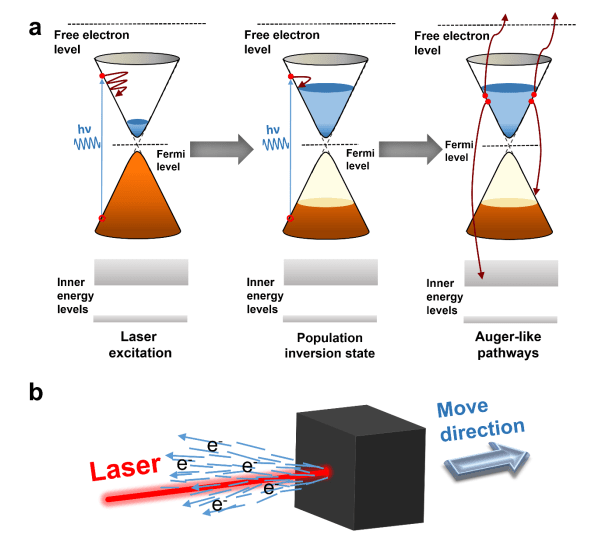'Graphene Sponge' Paves Way For Propulsion System In Solar Spacecrafts
The amazing properties of Graphene have been astonishing us all for quite some time now. Researchers are working hard on realizing the special material's true potential. In a recent research work done by Yongsheng Chen and his team from the Nankai University, it has come to light that 'Graphene Sponge", a moist soft material made by fusing together crumpled sheets of graphene oxide, could be the next game-changer for building a solar spacecraft that doesn't need fuel to run. The strong conductor of heat and electricity, Graphene has a flat structure. To optimally use the intrinsic properties of single layer graphene in a bulk material has been a real challenge for scientists because re-stacking of graphene sheets reduces most of those properties. To tackle this, the Chinese researchers showed how on properly assembling the sheets, the properties can remain unhurt.
The centimeter long graphene sponge material which has only a milligram weight was made to undergo an efficient light-induced ejected electron emission process, The force generated from such a mechanism is much larger than the one from the conventional light pressure. In a series of experiments, the team found that on focusing ordinary sunlight/laser on pieces of graphene sponge placed in vacuum using a lens, it could be moved upwards by as much as 40 cms. They even got the graphene to move by focusing ordinary sunlight on it with a lens.

Schematic Diagram of proposed mechanism
Photons can transfer momentum to an object and propel it forwards. The researchers believe that this small effect in the vacuum of space has the potential to build up enough thrust that can move a spacecraft. In their tests, they found that electric current was flowing away from the graphene sponge as it was exposed to a laser.
Although solar propulsion systems are efficient, they suffer from being too slow and need a neighbouring star to provide light energy. Traversing interstellar distances would require complex mechanism to achieve the desired flight path. With the freedom to move using sunlight without the need for fuel, if their efforts are completely successful, in the future, Graphene Sponge could beat solar sails to make a light-powered propulsion system for spacecrafts.
What are your thoughts about that? Share with us in comments below.
Source: #-Link-Snipped-#
The centimeter long graphene sponge material which has only a milligram weight was made to undergo an efficient light-induced ejected electron emission process, The force generated from such a mechanism is much larger than the one from the conventional light pressure. In a series of experiments, the team found that on focusing ordinary sunlight/laser on pieces of graphene sponge placed in vacuum using a lens, it could be moved upwards by as much as 40 cms. They even got the graphene to move by focusing ordinary sunlight on it with a lens.

Schematic Diagram of proposed mechanism
Photons can transfer momentum to an object and propel it forwards. The researchers believe that this small effect in the vacuum of space has the potential to build up enough thrust that can move a spacecraft. In their tests, they found that electric current was flowing away from the graphene sponge as it was exposed to a laser.
Although solar propulsion systems are efficient, they suffer from being too slow and need a neighbouring star to provide light energy. Traversing interstellar distances would require complex mechanism to achieve the desired flight path. With the freedom to move using sunlight without the need for fuel, if their efforts are completely successful, in the future, Graphene Sponge could beat solar sails to make a light-powered propulsion system for spacecrafts.
What are your thoughts about that? Share with us in comments below.
Source: #-Link-Snipped-#
Replies
-
 Ramani AswathVery nice physics. The issue will be how can enough light be captured and converted into a directed beam to achieve propulsion. One may still need large solar sails to reflect sunlight on to a processing device to convert it into a usable beam for propulsion. It may still happen. Interesting study really.
Ramani AswathVery nice physics. The issue will be how can enough light be captured and converted into a directed beam to achieve propulsion. One may still need large solar sails to reflect sunlight on to a processing device to convert it into a usable beam for propulsion. It may still happen. Interesting study really.
You are reading an archived discussion.
Related Posts
Microsoft is still testing the latest and the greatest Windows 10 operating system and is keeping lips tight closed about the pricing. However, it looks like an online retailer has...
hi,
I'am a passed out student from pondicherry engineering with B.tech specialization in EEE....i am interested in doing an internship in plc,scada,DCS.....cz i am kinda interested in automation sector.....then i...
The much awaited Asus Zenfone Selfie is in market now. Launched at Computex 2015 trade fair on Monday, Asus Zenfone Selfie is the next flagship in the Zenfone series, following...
Chinese electronics company Xiaomi released the Xiaomi Note and Mi 4i models in India in the month of April. And after this, if online sources are to be believed, Xiaomi...
As the Apple Watch tries to take control of the global premium smartwatch market with the help of loyal iOS supporters, Taiwanese electronics giant ASUS has launched its new Android...
